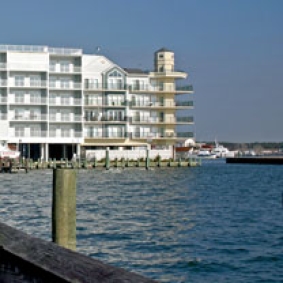Knauss legislative fellowships in Congress help build careers — and they're fun and educational. See our video and fact sheet for details.
How Atlantic Communities Are Preparing for Climate Change

Report Compiles Examples of Steps to Prepare for Increased Risk of Coastal Flooding
Adapting to climate change can be expensive, but some communities on the Atlantic Coast are finding ways to curb those costs. A new report provides a series of case studies detailing how.
The Mid-Atlantic region faces risks of increased coastal flooding because of climate change, which scientists say is likely to cause more severe hurricanes and accelerate sea level rise. So Connecticut Sea Grant and the NOAA North Atlantic Regional Team (NART) prepared a report that identifies 34 municipalities in the region that have discovered ways to make local climate change adaptation more effective and more affordable. The report includes three Maryland communities: Ocean City, Worcester County, and Somerset County and Crisfield.
 The year-long study, "Cost-Efficient Climate Change Adaptation in the North Atlantic," was designed to seek out the best adaptation strategies that Atlantic towns and cities were putting into effect. The goal was to share these efforts with other communities.
The year-long study, "Cost-Efficient Climate Change Adaptation in the North Atlantic," was designed to seek out the best adaptation strategies that Atlantic towns and cities were putting into effect. The goal was to share these efforts with other communities.
Some of these adaptation efforts include building tall sand dunes to shield coastal towns from crashing waves and flooding. Other municipalities have restricted how close homes, hotels, and other beachside buildings can be to the water, keeping new development safe from sea level rise
When selecting the cities and towns listed in the final report, the authors chose municipalities that demonstrated planning efforts in each of these areas: research, education and outreach, laws and policies, infrastructure, and cost-efficiency.
“With so much inherent geophysical, cultural, socioeconomic, and political variation, there is no one-size-fits-all magic solution for communities. But at the same time, there is no reason to reinvent the wheel in every community,” Peg Van Patten, communications director at Connecticut Sea Grant, wrote.
There is also an interactive map that shows the 34 municipalities and provides links to learn more about each location.
Notable adaptations mentioned in the report about Maryland municipalities include:
Ocean City
- Beach replenishment and protection: In 1992, the state of Maryland, Worcester County, and Ocean City spent $45 million to redesign the city beach, adding a boardwalk, a 25-foot-wide sand dune, and a partial seawall.
- Building codes: City codes mandate that new construction projects must be located 16.5 feet above sea level in the V zone (flood hazard areas). The city also restricts how close new beach developments can be to the ocean.
- Transfer of development rights: Under a new program, over 400 property rights were transferred to the city to allow the construction of new dunes. Property owners were compensated, and the city saved millions in land acquisition costs.
Worcester County
- Sea Level Rise Response Strategy: In 2008, the county published a report that modeled sea level rise up to 2100 with help from the Maryland Department of Natural Resources. The report includes an assessment of where the region is vulnerable to sea level rise and possible strategies for responding to those risks.
- Assateague Island: The report acknowledges that the preservation of this island would be expensive. But it also says that protecting land there “deserves mention as a farsighted, critically important adaptation” to brace the county against storm surges and other hazards.
Somerset County and Crisfield
- Rising Sea Level Guidance study: In 2008, Somerset County published the report Rising Sea Level Guidance using funds from Maryland’s CoastSmart Communities Initiative program. The report reviewed regional development codes, regulations, and existing plans that were relevant to sea level rise issues.
- CoastSmart Communities Initiative: This statewide program provides funding for climate adaptation planning in Somerset, Worcester, and Dorchester counties.
________________________
For more information about the report, contact:



